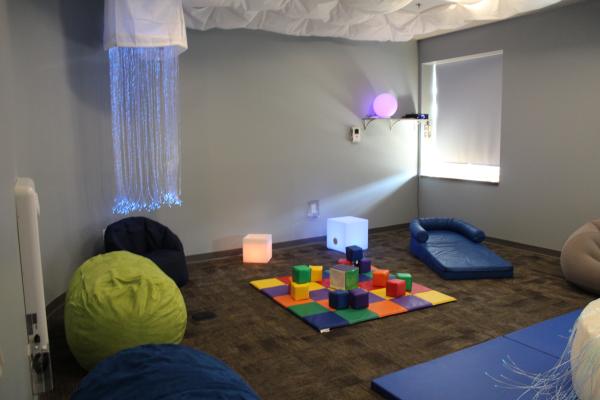Believe it or not, the origin story of Ocean County Library’s Sensory Space begins with the “Real Housewives of New Jersey.” A few years back, Jacqueline Laurita, cast member of the New Jersey franchise of Bravo’s hit show, posted a video on social media of her 8-year-old son with autism being asked to leave a library for having a brief meltdown.

“I wish everyone understood #Autism,” Laurita captioned the video. “Time to go back and educate them! Time for inclusion.” When Sara Siegler, avid “Real Housewives” viewer and assistant director of New Jersey’s Ocean County Library, saw the viral video, she asked herself what she would do if something like that ever happened at her library and how she could help prevent it. That’s when the idea of a Sensory Space came to mind.
I spoke with Siegler and the team at Ocean County Library who opened their Sensory Space in October 2021. Givane “Gigi” Hayes, assistant branch manager, Wendi Smolowitz, information services librarian & autism resources librarian, and Meredith Silvestri, sensory space assistant, discuss how the space is run and why every library should offer sensory-friendly programs.
Tell me about the community that Ocean County Library serves and the types of programs you offer.
Siegler: Ocean County Library is New Jersey’s largest library system. We serve a population of over 630,000 people on the Jersey Shore. Many veterans and seniors live here year-round, and our population increases ten-fold in the summer months during the vacation season.
Hayes: We have a very supportive community that expects high-quality and well-researched programs from us. We offer a little bit of everything: concerts, author visits, movie screenings, story times and teen programs, just to name a few. We also have large-scale events throughout the year, like our own version of Comic Con, gospel festivals and our annual Autism Resources Fair.
Siegler: We host our Autism Resources Fair every April. It’s been a wonderful way to connect with local organizations and get people connected to resources that they might have not known about before. Our service area has a higher-than-average population with autism. One in 35 in the state of New Jersey is diagnosed with autism compared to the nationwide average of one in 45.
So, what is a Sensory Room?
Smolowitz: A Sensory Room can be useful for everyone but particularly to those with developmental disabilities, PTSD, and people who have difficulty dealing with sensory issues like harsh, bright lights and loud noises. A Sensory Room is a quiet, chilled-out space with equipment made to help these individuals calm down. Sensory spaces are now becoming popular in airports and many other public facilities.
Silvestri: It’s a place to relax, decompress and add some calmness to the day. For example, our room has LED lighting, a musical touch wall, a ceiling covered in flouncy fabric, and a calming waterfall feature with a mirror to promote a relaxing environment. We have beanbags and other soft objects as well.
When did you see the need arise for a Sensory Room at your library?
Smolowitz: For years we have hosted programs such as sensory story times and other similar programs. We felt the need to do more than that. The idea for the Sensory Space took off from our experiences with hosting our annual Autism Resources Fair.
Siegler: After the story of the Housewives incident went viral, I was confident that my staff would not be the type to kick a child out of the library. However, I thought that even though we provide excellent customer service, is that enough? We offer great programs like sensory story time, but all in all, it felt like it wasn’t enough, but it did get the ball rolling.
A restaurant opened nearby that has a quiet area for people who might have sensory issues, and a local hospital’s emergency room has a calm area. Sensory spaces are meant to take the anxiety out of stressful situations and promote a sense of safety and calm. The fact that other local institutions had areas like this really put the idea in my head that these spaces are important to offer. We want our customers to have a great library experience, so why not also have our own Sensory Room at the library?
How did you get started on the creation of your space?
Hayes: Something we often do at the library is community scans. Branch managers will go into the community, drive around, look at census data and review who is coming to the library and who is not. The first step for us was knowing what kinds of people make up our community and what they want to see from us. This led us to start the Autism Resources Fair, which eventually led to the creation of the Sensory Space.
It’s evident that our community has really benefited from the space already. Because our library is in the downtown area, the room has become a calm haven for people who are attending festivals downtown and need a place to decompress. I’ve had families tell me they would’ve had to cut their outings short and go home if it wasn’t for the space to regroup. Stories like that really show that we are reaching important segments of the community.
Siegler: Once we got the “yes” from the county commissioner to make the space, we decided right away that this Sensory Room was not going to take the place of an occupational therapist’s office. We’re librarians, right? We’re not looking to play the role of an occupational therapist. We had to ask ourselves if we buy the equipment that we need to in order to make this space work, what are we then asking our staff to handle? Are they handling items that a trained professional would use, or are these things that anyone can use? It was important for us to pick items for the space that were appropriate for library staff to provide for a library customer.
You could spend a lot of money on the equipment that an occupational therapist could buy, but that’s not the purpose of our library’s room — nor should it be. We did have an occupational therapist come out and evaluate our equipment, and she gave us input on how to be safe and provide good experiences for users.
What types of programs are ideal for a Sensory Space?
Silvestri: In general, relaxed and slow-paced programs are great for a Sensory Room. You can host meditation and yoga classes for all ages and abilities or just leave out some coloring pages for a mindful, passive program.
Once a month, our Sensory Space runs programs with our Makerspace to combine sensory projects with Makerspace projects. For example, we’ve made sensory bracelets and stress-relief balls. A lot of families and groups that regularly come to the room also come to the Makerspace craft programs. It’s a great introduction to the Makerspace and other elements of the library’s programming.
We also do a sensory-friendly movie series. We don’t watch the movie in the Sensory Room, but I bring down bean bags, soft mats and other portable equipment. We had a family tell us that their child had never sat through an entire movie until they came to our sensory movie time!
In the Sensory Space, we also offer sensory processing programs with our youth services librarian that incorporates storytelling with movement and teen programs for our YA librarians to play chill music with activities geared toward teens. We are also exploring the possibility of offering the Sensory Space to our Memory Café program which is held to support people with early-stage memory loss and their care partners.
What advice would you share with libraries that want to create their own Sensory Room but don’t have the space and/or budget?
Hayes: If you don’t have the immediate availability of space, you can still do sensory programs for this community. Adjust your existing programs to be sensory-friendly, do your research, and reach out to other libraries to get ideas and tips for how they do their sensory programs. We looked at Louisville (Ohio) Public Library’s Sensory Space for inspiration.
Siegler: Even putting lights on a dimmer and playing some soothing music is a great program option! Sensory programs can be really cost-effective. We have a little video projector we bought for $35 that is a lot better than a $2,000 one. we passed on buying.
I would also say it’s important to have all staff members come into your Sensory Room or get them acquainted with any equipment you might have so everyone on staff can explain to library users what things are and how they work.
Silvestri: Anyone can do sensory programs even without a dedicated room. I see a lot of the families and users of our room every day who offer up their own ideas for programs. Start small and then talk to the people who are coming to your sensory programs and listen to them for guidance.
Any closing thoughts you would like to share?
Hayes: Because of the role that libraries play in communities, when we do programming for the disabled community, autistic community, for anyone experiencing PTSD and other segments, we are normalizing it.
Smolowitz: This really needs to be acknowledged and recognized, not just by libraries but by society in general. When we coordinate programs for the developmentally disabled, we are reaching out to another component of the community, and it is really appreciated.


